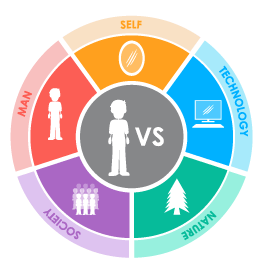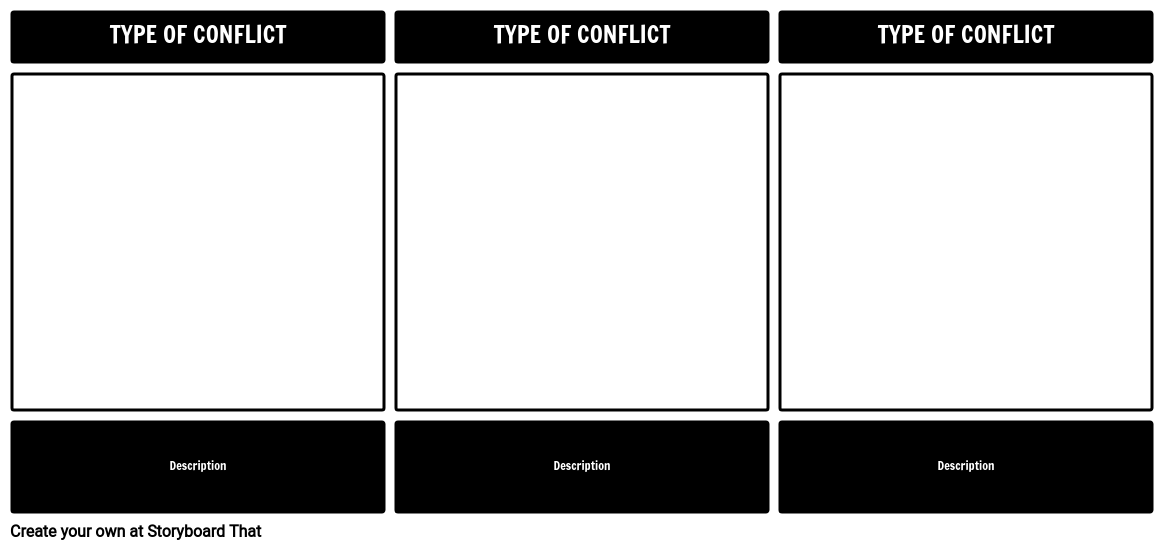Lesson Plan Overview
Storyboarding is an excellent way to focus on types of literary conflicts.
Having students create storyboards that show the cause and effect of different types of conflicts strengthens analytical thinking about literary concepts. Have your students choose an example of each literary conflict and depict them using the storyboard creator. In the storyboard, an example of each conflict should be visually represented, along with an explanation of the scene, and how it fits the particular category of conflict.
Examples of Literary Conflict in Twelfth Night
MAN vs. MAN
Sir Andrew is very jealous of Cesario because he holds the attentions of the Countess Olivia, even though Cesario is really Viola in disguise. He challenges Cesario to a duel at the prompting of Sir Toby, but after Antonio intervenes, thinking Cesario is Sebastian, Sir Andrew holds onto his grudge until he sees Sebastian and attacks him, thinking he is Cesario.
MAN vs. SELF
Malvolio, who is also in love with Olivia, is sent a mysterious letter which he believes to be from her, but it was written by Maria. It tells him to do ridiculous things, including smiling incessantly and wearing yellow stockings. Sir Toby, Fabian, and Maria lock him in a dark room, and Feste, the Fool, dresses as a priest and taunts him, making Malvolio begin to wonder if he really has gone mad. He requests a pen and paper so he can write to Olivia for help.
MAN vs. NATURE
A shipwreck at the beginning of the play places twins Viola and Sebastian on the island of Illyria, in the western Balkan islands. Each believes the other has drowned at sea, and they both think they have now lost all of their family members.
Template and Class Instructions
(These instructions are completely customizable. After clicking "Copy Activity", update the instructions on the Edit Tab of the assignment.)
Student Instructions
Create a storyboard that shows at least three forms of literary conflict in Twelfth Night.
- Click "Start Assignment".
- Identify conflicts in Twelfth Night.
- Categorize each conflict as Character vs. Character, Character vs. Self, Character vs. Society, Character vs. Nature, or Character vs. Technology.
- Illustrate conflicts in the cells, using characters from the story.
- Write a short description of the conflict below the cell.
Lesson Plan Reference
Student Rubric
(You can also create your own on Quick Rubric.)
| Proficient | Emerging | Beginning | Try Again | |
|---|---|---|---|---|
| Conflict Identification | Student identifies correct major conflicts and uses strong, clear textual evidence to support choice. | Student identifies correct major conflict and uses few or unclear details to support their choice. | Student identifies incorrect major conflict, and uses some details from the text to support their choice. | Student does not attempt to identify major conflict or identifies incorrect major conflict with no explanation. |
| Understanding Outcome | Student clearly shows the outcome of the conflict and its effects on the protagonist with evidence from the text. | Student shows the outcome of the conflict and its effect on the protagonist, but some evidence is unclear. | Student shows the outcome of the conflict, but does not examine its effect on the protagonist and uses some vague textual evidence. | Student does not clearly show the outcome of the conflict or use textual evidence. |
| Character | Storyboard includes all required characters and clearly names them. Goes above and beyond by adding additional details. | Storyboard includes all required characters and clearly names them. | Storyboard includes protagonist and antagonist but leaves out other required characters. | Storyboard does not include the names of required characters. |
| Storyboard | Student clearly shows effort to convey the setting the scene of the book | Student attempts to convey setting and scene of the book, but lacks some clarity. | Student does not clearly convey the setting and scene. | Student makes little or no attempt to convey the setting or scene. |
| Spelling and Grammar | Student uses exemplary spelling and grammar. There are no errors. | Student makes a minor error in spelling and grammar. | Student makes several minor errors in spelling and grammar. | Student makes many errors in spelling and grammar; little attempt at spellchecking. |
Lesson Plan Overview
Storyboarding is an excellent way to focus on types of literary conflicts.
Having students create storyboards that show the cause and effect of different types of conflicts strengthens analytical thinking about literary concepts. Have your students choose an example of each literary conflict and depict them using the storyboard creator. In the storyboard, an example of each conflict should be visually represented, along with an explanation of the scene, and how it fits the particular category of conflict.
Examples of Literary Conflict in Twelfth Night
MAN vs. MAN
Sir Andrew is very jealous of Cesario because he holds the attentions of the Countess Olivia, even though Cesario is really Viola in disguise. He challenges Cesario to a duel at the prompting of Sir Toby, but after Antonio intervenes, thinking Cesario is Sebastian, Sir Andrew holds onto his grudge until he sees Sebastian and attacks him, thinking he is Cesario.
MAN vs. SELF
Malvolio, who is also in love with Olivia, is sent a mysterious letter which he believes to be from her, but it was written by Maria. It tells him to do ridiculous things, including smiling incessantly and wearing yellow stockings. Sir Toby, Fabian, and Maria lock him in a dark room, and Feste, the Fool, dresses as a priest and taunts him, making Malvolio begin to wonder if he really has gone mad. He requests a pen and paper so he can write to Olivia for help.
MAN vs. NATURE
A shipwreck at the beginning of the play places twins Viola and Sebastian on the island of Illyria, in the western Balkan islands. Each believes the other has drowned at sea, and they both think they have now lost all of their family members.
Template and Class Instructions
(These instructions are completely customizable. After clicking "Copy Activity", update the instructions on the Edit Tab of the assignment.)
Student Instructions
Create a storyboard that shows at least three forms of literary conflict in Twelfth Night.
- Click "Start Assignment".
- Identify conflicts in Twelfth Night.
- Categorize each conflict as Character vs. Character, Character vs. Self, Character vs. Society, Character vs. Nature, or Character vs. Technology.
- Illustrate conflicts in the cells, using characters from the story.
- Write a short description of the conflict below the cell.
Lesson Plan Reference
Student Rubric
(You can also create your own on Quick Rubric.)
| Proficient | Emerging | Beginning | Try Again | |
|---|---|---|---|---|
| Conflict Identification | Student identifies correct major conflicts and uses strong, clear textual evidence to support choice. | Student identifies correct major conflict and uses few or unclear details to support their choice. | Student identifies incorrect major conflict, and uses some details from the text to support their choice. | Student does not attempt to identify major conflict or identifies incorrect major conflict with no explanation. |
| Understanding Outcome | Student clearly shows the outcome of the conflict and its effects on the protagonist with evidence from the text. | Student shows the outcome of the conflict and its effect on the protagonist, but some evidence is unclear. | Student shows the outcome of the conflict, but does not examine its effect on the protagonist and uses some vague textual evidence. | Student does not clearly show the outcome of the conflict or use textual evidence. |
| Character | Storyboard includes all required characters and clearly names them. Goes above and beyond by adding additional details. | Storyboard includes all required characters and clearly names them. | Storyboard includes protagonist and antagonist but leaves out other required characters. | Storyboard does not include the names of required characters. |
| Storyboard | Student clearly shows effort to convey the setting the scene of the book | Student attempts to convey setting and scene of the book, but lacks some clarity. | Student does not clearly convey the setting and scene. | Student makes little or no attempt to convey the setting or scene. |
| Spelling and Grammar | Student uses exemplary spelling and grammar. There are no errors. | Student makes a minor error in spelling and grammar. | Student makes several minor errors in spelling and grammar. | Student makes many errors in spelling and grammar; little attempt at spellchecking. |
How Tos about Identifying Literary Conflict in Twelfth Night
Plan a literary conflict debate for deeper student engagement
Organize a class debate where students defend or challenge how conflicts are resolved in Twelfth Night. This interactive activity encourages critical thinking and helps students articulate their understanding of each conflict type.
Assign debate teams and conflict topics
Divide your class into small teams and assign each a specific conflict from the play (e.g., Man vs. Man, Man vs. Self). This approach ensures focused preparation and gives every student a clear role.
Guide students to gather text evidence
Have students find quotes and scenes from Twelfth Night that illustrate their assigned conflict. This step builds close reading skills and grounds arguments in the text.
Coach teams to prepare arguments and rebuttals
Encourage each team to create a list of points supporting their viewpoint and possible counterpoints. This fosters collaboration and helps students anticipate opposing arguments.
Facilitate the debate and encourage respectful discussion
Moderate the debate, ensuring each team presents and responds. Emphasize respectful listening and clear communication so all students feel heard and engaged.
Frequently Asked Questions about Identifying Literary Conflict in Twelfth Night
What are the main types of literary conflict in Twelfth Night?
Twelfth Night features several types of literary conflict, including Man vs. Man (character vs. character), Man vs. Self (internal conflict), and Man vs. Nature (struggles against external forces like the shipwreck). Each type drives the plot and reveals character motivations.
How do I teach literary conflict using storyboards for Twelfth Night?
To teach literary conflict with storyboards, have students identify examples of conflict in Twelfth Night, categorize them (e.g., character vs. character, self, nature), visually illustrate each scene, and write brief explanations. This hands-on activity deepens understanding and analytical skills.
Can you give examples of character vs. self conflict in Twelfth Night?
One example of character vs. self in Twelfth Night is Malvolio's struggle after being tricked by a fake letter. He begins to doubt his sanity and questions his own perceptions, showcasing an internal conflict.
Why is identifying literary conflict important when teaching Shakespeare?
Identifying literary conflict helps students understand character motivations, plot development, and thematic depth in Shakespeare's plays. It encourages critical thinking and allows students to connect emotionally with the story.
What is the best way to help students differentiate types of conflict in Twelfth Night?
The best way is to use visual tools like storyboards to categorize and illustrate each conflict type, such as character vs. character or character vs. nature. Short written descriptions reinforce comprehension and help students distinguish between conflict categories.
More Storyboard That Activities
Twelfth Night
Testimonials

“By using the product, they were so excited and they learned so much...”–K-5 Librarian and Instructinal Technology Teacher

“I'm doing a Napoleon timeline and I'm having [students] determine whether or not Napoleon was a good guy or a bad guy or somewhere in between.”–History and Special Ed Teacher

“Students get to be creative with Storyboard That and there's so many visuals for them to pick from... It makes it really accessible for all students in the class.”–Third Grade Teacher
© 2026 - Clever Prototypes, LLC - All rights reserved.
StoryboardThat is a trademark of Clever Prototypes, LLC, and Registered in U.S. Patent and Trademark Office








